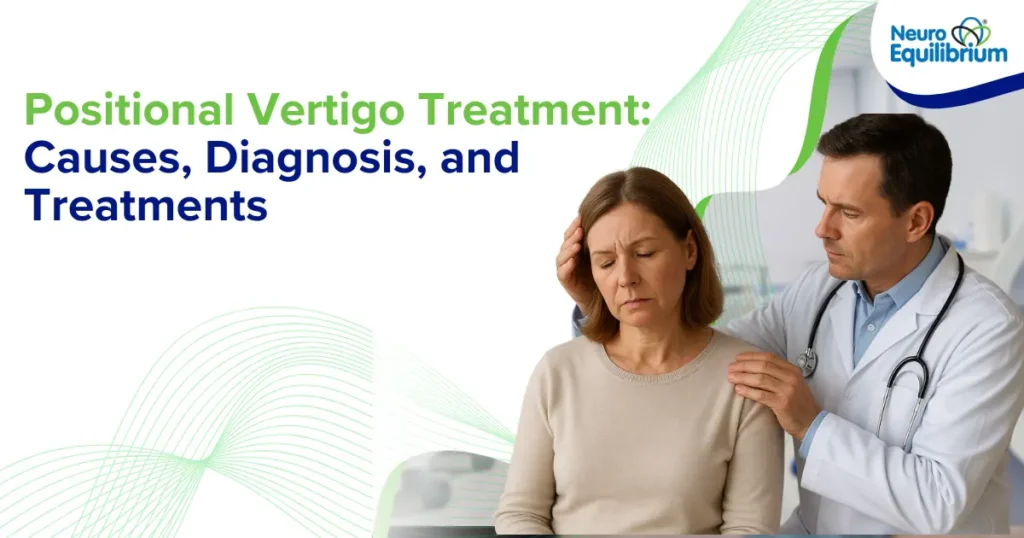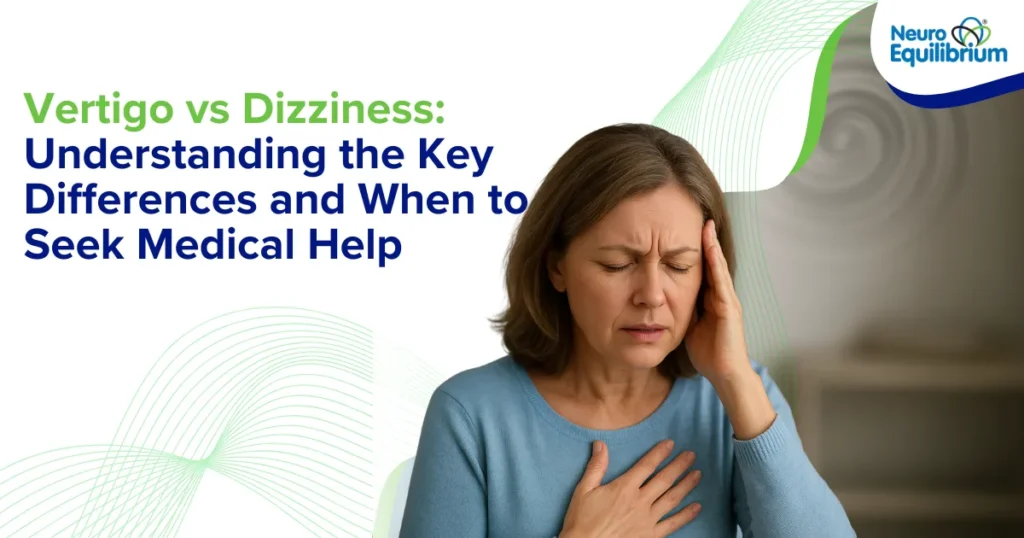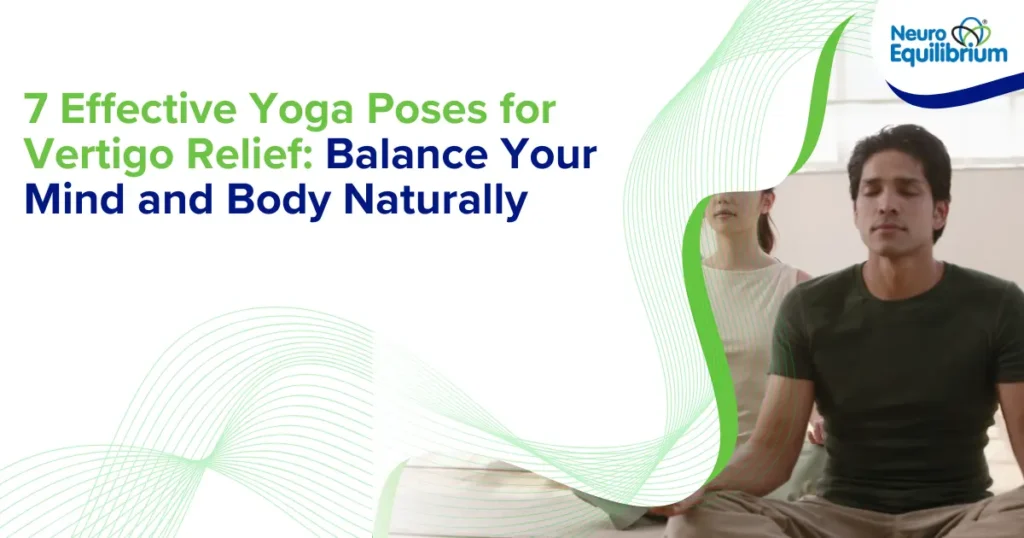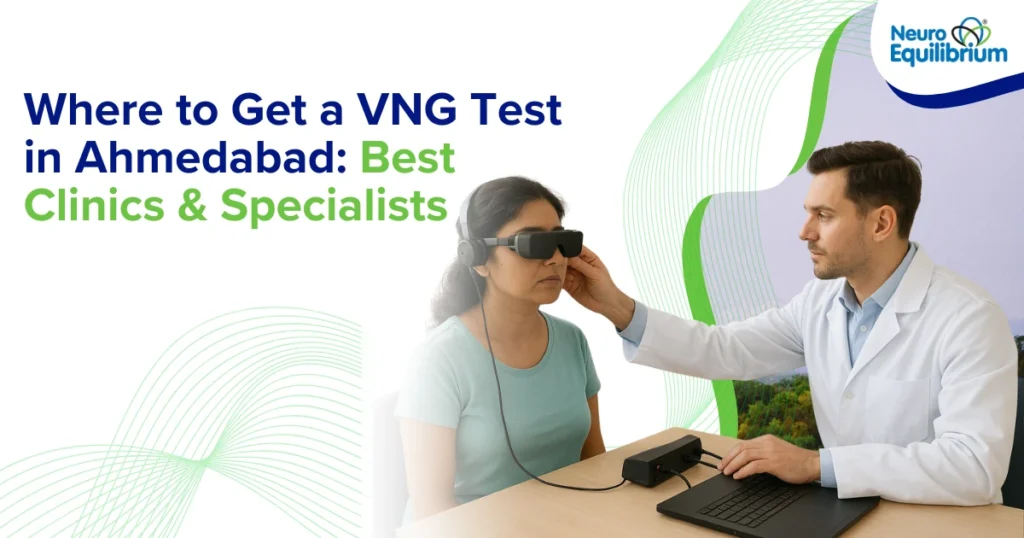It can be disorienting to feel movement even when you’re standing still. Some people describe it as if the room is tilting forward, the floor is dropping, or one side of their body is being pulled. If you’ve ever felt this kind of spinning sensation, it could be positional vertigo.
In simple terms, positional vertigo occurs when some movements of the head, such as rolling in bed, raising your head up, bending down or sitting up quickly, all of a sudden make you feel dizzy. These dizzy spells are brief but intense and can cause nausea or a feeling of unsteadiness.
What Is Positional Vertigo?
Positional vertigo is most commonly associated with an issue of the inner ear, which is the section of the body that ensures a person is upright.
These tiny calcium crystals, which are contained within the inner ear, aid the brain in understanding your body’s position. When these crystals get into the incorrect section of the ear canal, the balance system transmits conflicting messages. This causes the spinning effect referred to as vertigo.
This vertigo is also referred to as:
- BPPV (Benign paroxysmal positional vertigo)
- Dizziness when the head is turned.
- “Sudden vertigo attacks”
The most promising: Positional vertigo is among the most treatable types of dizziness.
Vertigo vs Positional Vertigo
| Aspect | Vertigo | Positional Vertigo (BPPV) |
| What it is | A general term for feeling like you or the surroundings are spinning or moving | A specific type of vertigo triggered by certain head positions or movements |
| Cause | Can be caused by several conditions (inner ear problems, migraines, infections, etc.) | Usually caused by tiny calcium crystals in the inner ear moving where they shouldn’t be |
| Triggers | May happen anytime, not tied to one type of movement | Triggered by actions like turning in bed, looking up, bending down, or rolling over |
| Duration of Episodes | Can last minutes to hours depending on the cause | Usually lasts a few seconds to a minute per episode |
| Main Symptoms | Spinning feeling, nausea, trouble balancing, sometimes hearing changes | Brief spinning sensation, nausea, unsteadiness, usually no hearing changes |
| Diagnosis | Requires medical evaluation to find the underlying cause | Often diagnosed with quick head movement tests (e.g., Dix-Hallpike test) |
| Treatment | Depends on the underlying cause (medication, therapy, etc.) | Treated mainly with repositioning maneuvers like the Epley maneuver |
| Recovery Time | Varies depending on cause and treatment | Often improves quickly once treated properly |
Know More About Vertigo
- Vertigo Exercises And Home Remedies
- How to Stop Vertigo–Simple Steps That Work
- What to Expect During Vertigo Treatment
Common Symptoms of Positional Vertigo
People often report:
- Sensation of spinning/whirling suddenly.
- Loss of balance, turning in bed or looking up.
- A feeling of dizziness or weakness when walking.
- During episodes, nausea or vomiting.
- Trouble focusing visually
- Fears of frequent dizzy attacks.
Although the symptoms are not persistent, they can be experienced in seconds, but the fear of the next episode can impact everyday life.
What Causes Positional Vertigo?
Other causes of dizziness might also exist even though BPPV is the most common:
- BPPV caused by displaced inner ear crystals: This occurs when calcium particles move into the wrong part of the ear canal, triggering spinning sensations when the head moves.
- Ear infections: These infections can cause rupture in the signals transmitted by your inner ear to your brain regarding balance.
- Migraine: This is accompanied by some migraines that can be accompanied with dizziness or vertigo.
- Head trauma: Trauma may involve the inner ear and balance system.
- Aging: Balance problems can be caused when people age normally.
Is Positional Vertigo Serious?
Positional vertigo is not harmful in the majority of cases. Nevertheless, unless it is addressed, it may cause problems in everyday life. Part of the potential issues is:
- Tripping or injuries: It is possible to fall due to sudden dizziness. It exposes the patient to the risk of slipping, tripping or falling, particularly when leaving the bed or walking.
- Diving out: There are those people who start avoiding day-to-day activities such as going outside or keeping on a move since they are afraid the dizziness will occur again. This may restrain self-sufficiency and self-confidence.
- Physical fatigue: You may feel tired because of the constant feeling of dizziness. You can work harder to keep yourself steady and this may cause exhaustion.
- Stress and anxiety: It might make one emotionally strained not knowing when they are going to feel dizzy. Most individuals are anxious, nervous or concerned with their symptoms.
It is important to get an adequate medical evaluation and treatment plan. This guarantees recovery that is safe and prevents complications and a faster recovery to normal functions.
How Is Positional Vertigo Diagnosed at NeuroEquilibrium?
Diagnosing BPPV is like finding a tiny pebble that has slipped into the wrong part of a water pipe system inside the ear. Since doctors cannot look directly inside, they gently move the head to shift the pebble, and the VNG camera watches the eyes for tiny movement patterns that reveal where the pebble is stuck. Once the location is known, the correct maneuver can be used to guide it back to where it belongs.
Advanced Diagnostic Services Include:
| Diagnostic Step | What Happens |
| 1. Positional Testing | The doctor guides the patient into specific head and body positions to trigger dizziness and help detect which part of the inner ear is affected. |
| 2. Videonystagmography (VNG) | The patient wears goggles with infrared cameras that record precise eye movements. These movements help identify nystagmus accurately. |
| 3. Dix-Hallpike Test | Used to determine if the posterior semicircular canal is affected. |
| 4. Supine Roll Test | Used to check for involvement of the horizontal semicircular canal. |
| 5. Deep Head Hanging Test | Used to identify issues in the anterior semicircular canal. |
| 6. Interpreting Nystagmus | The pattern and direction of the eye movements reveal the exact location of the displaced crystals and the type of BPPV. |

Positional Vertigo Treatment (Step-by-Step Approach)

Once the diagnosis is clear, treatment focuses on correcting the root cause, not just suppressing symptoms.
1. Repositioning Manoeuvres for BPPV (Core Treatment)
NeuroEquilibrium specialises in treating all 14 variants of BPPV using precise manoeuvres:
- Epley Maneuver
- Semont Maneuver
- Barbecue / Roll Manoeuvre
- Zuma Maneuver
Such manoeuvres help in pushing the moved crystals to the right back to their positions in the utricle.
The 3D humanoid head-position guidance ensures that clinicians can guarantee the precision of the movements, and it has a higher success rate.
Findings: A significant number of patients will experience considerable relief within one to two sessions.
2. Vestibular Rehabilitation Therapy (VRT)
If imbalance or dizziness persists, VRT helps retrain the brain and restore stable movement.
NeuroEquilibrium offers VR-based VRT, which makes therapy more engaging and effective.
VR Rehabilitation Benefits:
- Recreates real-life situations (e.g., streets, bumpy roads)
- Enhances eye focus and balance assurance.
- Gradual desensitization reduces dizziness triggered by motion or visual stimuli
- Digital tracking allows therapists to personalise each session based on patient progress.
Exercises include:
- The gaze stabilisation training.
- Activities of balance and coordination.
- Ambulation and orientation training.
To enhance reflexes, entertaining motion exercises such as juggling may be included in some sessions.
3. Psychological & Emotional Support
The persistent feeling of dizziness may lead to anxiety and excessive cogitation. In instances where nervousness aggravates symptoms:
- CBT (Cognitive Behavioural Therapy) is provided to negate the fear-dizziness loop.
- In the healing process, counselling develops coping mechanisms and self-esteem.
4. Medical & Lifestyle Management
Depending on the underlying condition:
- Medication can be applied (e.g., migraine, Meniere’s Disease, or Vestibular neuritis)
- Food and sleeping habits can help to diminish triggers.
- Fall prevention interventions enhance the safety of elderly people.
Medication is not the long-term solution, but rather the solution upon requirement.
Conclusion
When somebody nearby is experiencing spontaneous spinning or dizziness, it is distressing and disorienting. Nevertheless, positional vertigo is quite curable. Most individuals can recover and regain normalcy with the help of trained specialists with the right diagnosis and proper therapy.
NeuroEquilibrium is the clinic that treats vertigo and balance issues, offers VR-rehabilitation, and has numerous branches throughout India.
Don’t ignore these symptoms if you or someone you know is experiencing them.
Book an appointment at your nearest NeuroEquilibrium clinic to get expert assistance.
The quicker the treatment is received the quicker the recovery.
Can Benign Paroxysmal Positional Vertigo (BPPV) go away on its own?
Yes, in other instances BPPV may resolve itself because the crystals in the inner ear slowly resume their position. Nonetheless, a trained specialist can be more efficient and fast in rescue with the help of repositioning maneuvers. Home remedies can be insufficient to correct the problem and ensure that it does not reoccur.
Why do I feel spinning when I move my head
Spinning experience is caused by the fact that small crystals of calcium in the inner ear have fallen into semicircular canals where they are not supposed to be. “When you move your head such as turning in bed or looking up, these crystals disturb the fluid in your ear canals, sending exaggerated balance signals to the brain and causing vertigo. This gives conflicting messages to the brain and this brings about the sudden experience of vertigo.
Is Positional Vertigo (BPPV) curable?
In many cases, yes. Since BPPV is a mechanical issue, repositioning maneuvers can move the displaced crystals back to their correct location. When the correct maneuver is used, many people experience relief very quickly, and the condition can be resolved.
Is BPPV dangerous?
BPPV is not in itself harmful but it is not permanent in its effects. What matters is the dizziness which may result in falls or accidents involving balance. This is more critical among the seniors. BPPV therapy minimizes this risk and assists to regain confidence and balance in motion.
How long does recovery take after treatment?
Many people feel better right after the proper maneuver is performed. Some may need one to three sessions to experience full relief. If slight dizziness remains afterward, it usually improves with gentle vestibular rehabilitation exercises over several days or weeks.















